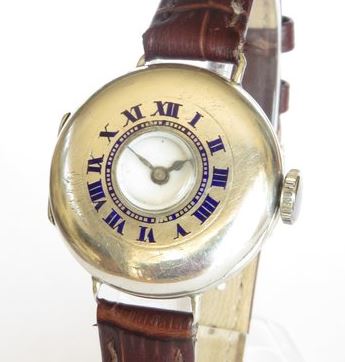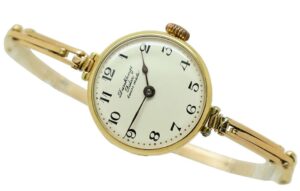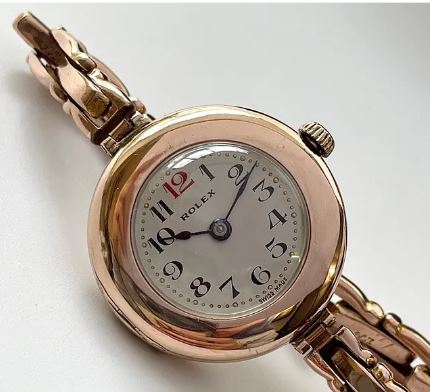Last updated on November 16, 2025
Ladies’ antique watches, sadly, do not feature prominently in these Time Worn Watches pages. It has not been a deliberate omission. It’s simply because, as the major contributor, I wear men’s watches. However, an upcoming post will feature a ladies’ watch, so I thought I should give some background on the world of ladies’ antique watches.
The market
Generally speaking, men’s antique watches tend to command higher values than ladies’ antique watches. There are several reasons for this, based on historical context, design priorities, and market demand. Historically, watches were primarily a gentleman’s accessory, particularly pocket watches. They were seen as symbols of status, control, and social standing. Men had more freedom to spend money on new items and display them at social events. However, women did adapt timepieces for their own use, initially as decorative items worn on necklaces, brooches, or bracelets. The emphasis for ladies’ watches often leaned heavily towards ornamentation rather than complex mechanical innovation. Early ladies’ wristwatches, for instance, were often designed to be as small as possible, leaving room for precious stones and engraving, rather than focusing on intricate complications (The history of women’s wristwatches at First Class Watches).
20th century developments
The development of men’s wristwatches, particularly in the early 20th century, was significantly driven by practical needs. Trench watches, for example, proved far more convenient for soldiers than pocket watches. This consolidated the wristwatch’s image as a robust, functional necessity and a symbol of modernity and progress. This focus on utility often led to the development of more complex movements and complications in men’s watches. This included chronographs or perpetual calendars, which require significant technical skill to create and are highly valued by collectors. While ladies’ watches eventually incorporated some complications, the primary design focus was elegance and miniaturisation (Invention of the Wristwatch at SwissWatchExpo).
The current market demand plays a crucial role. The resale value for ladies’ antique watches is generally lower than for men’s watches. Additionally, men’s watches are often considered a better investment for future resale. There are simply more watches and watch designs overall that were made for and marketed to men. There is a growing interest among women in collecting luxury watches, including vintage men’s models. However, the market has historically prioritised the attributes often found in men’s timepieces. This includes robust mechanical movements, technical innovations, and larger sizes.
The evolution of ladies’ watches
For centuries, portable timepieces took the form of a pocket watch, a palm-sized case easily slipped into a waistcoat pocket. This became a significant trend among men, particularly those of higher social status. However, this trend did not translate easily to women’s fashion. The elaborate dresses worn by upper-class women were simply not designed with pockets. Indeed, owning a watch seemed almost entirely a gentleman’s privilege in the late 19th and early 20th centuries.

Despite these limitations, ladies soon recognised their own desire for a personal timepiece. They adapted existing pocket watches by threading them onto necklaces, brooches, and bracelets. This demonstrated a clear demand for personal timekeeping among women. This prompted watchmakers to begin producing timepieces specifically for them, laying the groundwork for the wristwatch.
This demand was behind the emergence of the wristwatch, initially conceived as a decorative accessory for women. It is widely believed that Abraham-Louis Breguet created the very first wristwatch in 1810 for Caroline Murat, the Queen of Naples. It was an oval repeater watch with complications, mounted on a wristlet of hair and gold thread.. Following this, in 1868, the Swiss company Patek Philippe designed a piece of jewellery that doubled as a watch for Countess Koscowicz of Hungary, setting a trend for timepieces to be both ornamental and functional. Queen Victoria herself later owned two Patek Philippe watches, further cementing the association of these timepieces with royalty and high society (Queen of Naples wristwatch at Breguet).
Market demand
These early wristwatches came with a significant price tag, making them largely inaccessible to the majority of the population. Consequently, only aristocratic women and those within the European Royal Courts wore them. It was not until the very end of the 19th century that women’s wristwatches truly became mainstream. As their popularity soared, more watchmakers began producing them. This gradually made wristwatches more accessible to a wider audience, though they often retained their luxury status well into the early 1900s. The development of the wristwatch for women was not merely a technological advancement but a direct response to market demand.
As women’s roles in society continued to evolve, so did the design and wearing of their watches. The increasing number of women participating in employment and sports, which made carrying a pocket watch difficult, contributed to the rise of wristwatches. Additionally, wristwatches proved far more practical for women working in factories during World War I, allowing for easy timekeeping on the job. What began as a fashion adaptation due to the constraints of female attire evolved into a tool that eased women’s entry into public life, sports, and the workforce.
Design, materials, and style
Antique ladies’ watches are known for their intricate designs and craftsmanship. These details ranged from delicate floral motifs to intricate filigree patterns, all adding to a layer of elegance and sophistication. Engravings often adorned the watch’s case, dial, or even its inner mechanisms. Watchmakers frequently incorporated precious metals such as gold, silver, and platinum. Gemstones such as diamonds, rubies, and sapphires were often used to add brilliance and a touch of luxury. Dials themselves were crafted from exquisite materials, including enamel, porcelain, or even mother-of-pearl.
The late 19th and early 20th centuries saw two distinct artistic movements profoundly influence ladies’ watch design. Art Nouveau, prevalent from 1890 until 1910, drew inspiration from natural forms. It is characterised by its curvilinear shapes and distinctive “whiplash lines”. The main themes of Art Nouveau jewellery and watches were nature and the human figure, particularly women. In contrast, Art Deco, which flourished from the 1920s, had a strong emphasis on sharp, geometric lines and imagery that celebrated the arrival of the Machine Age. Watches from this era often featured rectangular cases, a departure from the traditional circular form (Art Deco and Art Nouveau Movements at Rug & Kilim).
Conclusion
The journey of ladies’ watches from the 16th century to the 1920s reflects the evolution of fashion, societal expectations, and watchmaking innovation. What began as a male-dominated accessory transformed into a symbol of feminine elegance and practicality. High-profile brands, such as Rolex, Omega and Longines, all offered ladies’ watches before they included gentlemen’s models in their ranges. The modern market for ladies’ antique and vintage watches is seeing a consistent increase in demand. Unlike a new watch, which will suffer depreciation as soon as it leaves the showroom, an antique piece will hold its value and rise in value over time. Owning an antique watch means it is highly unlikely that you will ever come across someone else wearing the same model.
Related content
Vintage ladies watches at Time Rediscovered.

